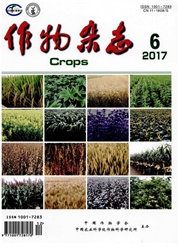

 中文摘要:
中文摘要:
研究了微生物菌液与不同浓度的硼、锌组合后对盐胁迫条件下棉苗生物量、叶绿素含量及Na+分布状况的影响。利用紫外分光光度计法测定了叶绿素含量,Z-8000型原子吸收分光光度计测定了Na+含量。结果表明:在滴加微生物菌体时,混合加入B2+和Zn^2+利于棉苗的生长和叶绿素的形成,最佳浓度为100μg/LB^2+和100μg/LZn^2+。在此处理下根长、株高、干重和鲜重相对于对照有所提高;叶绿素a、叶绿素b、总叶绿素及类胡萝卜素的含量分别提高了3.14、2.46、4.37和1.80倍;棉株根和叶中Na+含量对根系的影响更大,微生物菌体与100μg/LB^2+和100μg/LZn^2+混合处理比对照棉苗根部Na+的吸收量约降低了43%,比叶部Na^+的吸收量约降低了41%。微生物与适宜的硼、锌组合可以提高作物的生物量和叶绿素含量,降低植株体内Na^+的绝对吸收量。
 英文摘要:
英文摘要:
Effects of microorganisms coupled with an amount of trace elements boron and zinc on the growth and development of cotton seedlings, chlorophyll content and Na^+ distribution in cotton under salt stress were investigated. The results revealed that coupled with 100μg/LB^2+ and 100μg/L ZB^2+ in microorganisms,there was no significant improvement in the individual plant height, root length, dry weight, fresh weight of cotton in compared with the CK. In addition, chlorophyll a, chlorophyll b, total chlorophyll and carotenoids contents were 3. 14,2. 46,4. 37 and 1.80 times better than the control,respectively. The results also demonstrated that the content of Na^+ in different positions of cotton decreased after treated with 100μg/L B^2+ and 100p, g/L Zn^2+ mixed with microorganisms,and the content of Na^+ in root and in leaf decreased by 43% and 41% ,respectively. Microorganisms composed of an amount of trace elements B and Zn could improve the biomassand chlorophyll content, and also could decrease the absolute absorption of Na^+.
 同期刊论文项目
同期刊论文项目
 同项目期刊论文
同项目期刊论文
 Cloning, expression and reactivating characterization of glycerol dehydratase reactivation factor fr
Cloning, expression and reactivating characterization of glycerol dehydratase reactivation factor fr Microbial Production of 1,3-Propanediol by Klebsiella pneumoniae XJPD-Li under Different Aeration St
Microbial Production of 1,3-Propanediol by Klebsiella pneumoniae XJPD-Li under Different Aeration St Biosynthesis of glycyrrhetic acid 3-O-mono- β -d-glucuronide catalyzed b-d-glucuronidase with enhanc
Biosynthesis of glycyrrhetic acid 3-O-mono- β -d-glucuronide catalyzed b-d-glucuronidase with enhanc Simulated microgravity affects growth of Escherichia coli and recombinant β -D-glucuronidase product
Simulated microgravity affects growth of Escherichia coli and recombinant β -D-glucuronidase product Enhancement of recombinant β -D-glucuronidase production under low-shear modeled microgravity in Pic
Enhancement of recombinant β -D-glucuronidase production under low-shear modeled microgravity in Pic Effects of Low- Shear Modeled Microgravity on the Characterization of Recombinant β -D-Glucuronidase
Effects of Low- Shear Modeled Microgravity on the Characterization of Recombinant β -D-Glucuronidase Preparation of calcium alginate microcapsuled microbial fertilizer coating Klebsiella oxytoca Rs-5 a
Preparation of calcium alginate microcapsuled microbial fertilizer coating Klebsiella oxytoca Rs-5 a 期刊信息
期刊信息
